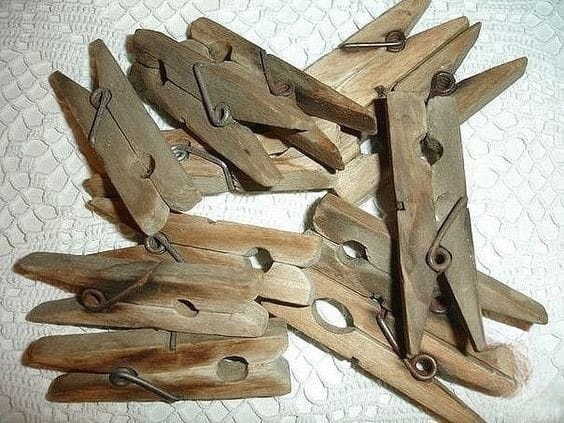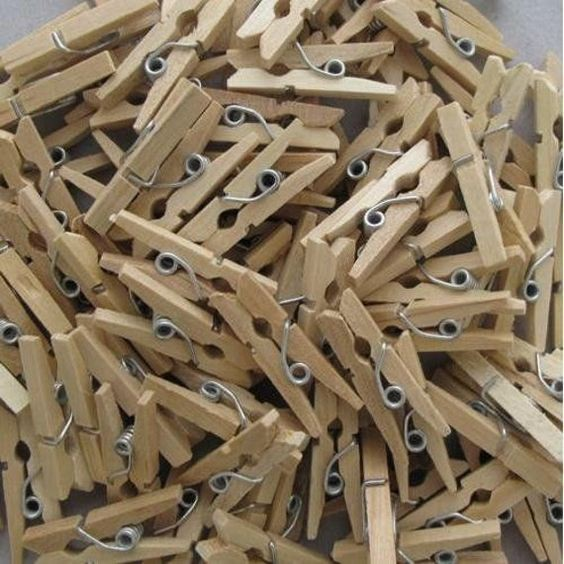The clothespin, also known as a clothes peg in some parts of the world, is a simple yet incredibly useful tool. From its humble beginnings to its modern-day use in households and even art installations, the clothespin has undergone significant transformations. First introduced in its modern form in 1853 by David M. Smith of Vermont, this seemingly unassuming object continues to serve a vital role in our daily lives. Let’s take a closer look at the fascinating history, evolution, and surprising uses of the clothespin.
The Birth of the Modern Clothespin: David Smith’s 1853 Invention

In 1853, David M. Smith revolutionized laundry day by inventing the modern two-piece clothespin. Prior to his innovation, hanging clothes to dry involved the use of rudimentary methods, such as draping them over bushes or tying them with makeshift ropes. Smith’s design was groundbreaking, featuring two pieces of wood and a small metal spring that allowed the clothespin to clamp clothes securely onto a line.
This new invention made it easier to secure wet laundry and prevent it from falling in the wind, which became especially important in households that relied on outdoor drying lines. The spring-loaded mechanism became the standard, setting the foundation for future improvements.
Solon E. Moore’s 1887 Improvement: The Coiled Fulcrum
In 1887, Solon E. Moore made a significant enhancement to Smith’s design by introducing the coiled fulcrum. This single-wire spring not only held the wooden pieces together but also provided the necessary tension for a stronger grip. The simplicity of the design eliminated the need for extra components, making the clothespin cheaper and easier to manufacture.
Moore’s innovation took the market by storm. The clothespin became widely available, and Vermont quickly earned the reputation of being the “Silicon Valley of Clothespin Manufacturing.” The United States Clothespin Company capitalized on this success and produced Moore’s improved version in mass quantities, making it a household staple across America.
From Wood to Plastic: The Transition to Modern Materials
While the original clothespins were made from wood, the 20th century brought about a shift toward plastic. The introduction of plastic clothespins offered durability and weather resistance, making them ideal for outdoor use. Plastic models also allowed for greater customization in terms of shape, size, and color, which appealed to consumers seeking both functionality and style.
Despite the benefits of plastic, wooden clothespins are still cherished by many for their rustic charm and eco-friendliness. However, plastic clothespins now dominate the market due to their affordability and longevity.
Unexpected Uses for Clothespins Beyond Laundry
While the primary function of a clothespin is to fasten laundry to a clothesline, their versatility has led to a surprising range of alternative uses. For example, craft enthusiasts frequently use clothespins in DIY projects, creating everything from holiday ornaments to picture holders. In schools, children use them to construct creative art pieces, and their simple design makes them a favorite for hands-on activities.
Clothespins also find utility in the kitchen, where they can be used to seal bags of chips or hold together stacks of paper. On film sets, they’re referred to as C47s and are used by crew members to secure lighting gels to hot lights, as the wooden version is heat resistant. This multi-functionality showcases how a single object can be repurposed in various settings beyond its intended use.
Public Art and the Influence of the Humble Clothespin

Beyond practical applications, the clothespin has also made its way into the world of public art. One of the most famous examples is Claes Oldenburg’s “Clothespin” sculpture in Philadelphia. This 45-foot steel sculpture stands as an iconic landmark in the city, directly across from City Hall. The piece blends everyday utility with monumental art, serving as a reminder of the clothespin’s cultural significance.
Moreover, in Vermont, a giant 5-foot granite clothespin marks the grave of Jack Crowell, the last owner of the National Clothespin Company, which was once the leading manufacturer of clothespins in the U.S. This symbolic marker highlights the deep ties the clothespin industry had with the region, and how its legacy continues to resonate today.
Clothespin Celebrations: Honoring an Everyday Object
In the U.K., the clothespin has even inspired an annual celebration. Each May 6, a small but dedicated group of enthusiasts gathers to celebrate Peg Day, often marking the occasion with sunny weather and light-hearted festivities. What started as a humorous gift exchange involving pegs has now turned into a lighthearted tradition, celebrating the humble yet indispensable clothespin.
The Decline of the Clothespin Industry and Its Legacy

While clothespins were once an essential household item, the rise of the electric clothes dryer in the mid-20th century led to a decline in demand. This, combined with the influx of cheap imports from Europe and later from China, spelled the end for many American clothespin manufacturers. The United States Clothespin Company shut down in the 1940s, and the National Clothespin Company—the last of its kind—ceased production in 2009.
Despite the decline in manufacturing, the clothespin’s legacy lives on. Whether used for drying clothes, crafting, or as an art object, this simple device has earned a permanent place in our homes and history.
Conclusion: The Enduring Relevance of the Clothespin
From its invention in the 1850s to its evolution into modern plastic designs, the clothespin has come a long way. While its role in drying laundry has diminished due to technological advancements, its versatility ensures it remains relevant. From its historical importance in American manufacturing to its use in art and film, the clothespin is far more than just a tool for laundry—it’s a symbol of creativity, utility, and cultural significance.
So next time you reach for a clothespin, take a moment to appreciate its long and storied history, and remember that even the simplest objects can have a profound impact on our daily lives.


